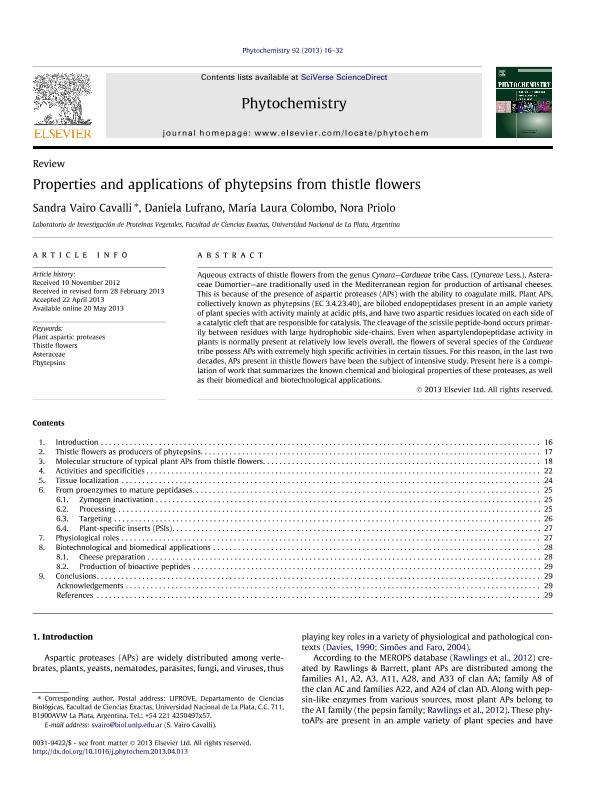Mostrar el registro sencillo del ítem
dc.contributor.author
Vairo Cavalli, Sandra Elizabeth

dc.contributor.author
Lufrano, Daniela

dc.contributor.author
Colombo, Maria Laura

dc.contributor.author
Priolo, Nora Silvia

dc.date.available
2017-08-25T22:01:26Z
dc.date.issued
2013-05
dc.identifier.citation
Vairo Cavalli, Sandra Elizabeth; Lufrano, Daniela; Colombo, Maria Laura; Priolo, Nora Silvia; Properties and applications of phytepsins from thistle flowers; Elsevier; Phytochemistry; 92; 5-2013; 16-32
dc.identifier.issn
0031-9422
dc.identifier.uri
http://hdl.handle.net/11336/23084
dc.description.abstract
Aqueous extracts of thistle flowers from the genus Cynara—Cardueae tribe Cass. (Cynareae Less.), Asteraceae Dumortier—are traditionally used in the Mediterranean region for production of artisanal cheeses. This is because of the presence of aspartic proteases (APs) with the ability to coagulate milk. Plant APs, collectively known as phytepsins (EC 3.4.23.40), are bilobed endopeptidases present in an ample variety of plant species with activity mainly at acidic pHs, and have two aspartic residues located on each side of a catalytic cleft that are responsible for catalysis. The cleavage of the scissile peptide-bond occurs primarily between residues with large hydrophobic side-chains. Even when aspartylendopeptidase activity in plants is normally present at relatively low levels overall, the flowers of several species of the Cardueae tribe possess APs with extremely high specific activities in certain tissues. For this reason, in the last two decades, APs present in thistle flowers have been the subject of intensive study. Present here is a compilation of work that summarizes the known chemical and biological properties of these proteases, as well as their biomedical and biotechnological applications.
dc.format
application/pdf
dc.language.iso
eng
dc.publisher
Elsevier

dc.rights
info:eu-repo/semantics/openAccess
dc.rights.uri
https://creativecommons.org/licenses/by-nc-nd/2.5/ar/
dc.subject
Plant Aspartic Proteases
dc.subject
Thistle Flowers
dc.subject
Asteraceae
dc.subject
Phytepsins
dc.subject.classification
Bioquímica y Biología Molecular

dc.subject.classification
Ciencias Biológicas

dc.subject.classification
CIENCIAS NATURALES Y EXACTAS

dc.title
Properties and applications of phytepsins from thistle flowers
dc.type
info:eu-repo/semantics/article
dc.type
info:ar-repo/semantics/artículo
dc.type
info:eu-repo/semantics/publishedVersion
dc.date.updated
2017-08-17T17:42:09Z
dc.journal.volume
92
dc.journal.pagination
16-32
dc.journal.pais
Países Bajos

dc.journal.ciudad
Amsterdam
dc.description.fil
Fil: Vairo Cavalli, Sandra Elizabeth. Universidad Nacional de la Plata. Facultad de Ciencias Exactas. Departamento de Ciencias Biologicas. Laboratorio de Investigacion de Proteinas Vegetales; Argentina. Consejo Nacional de Investigaciones Científicas y Técnicas; Argentina
dc.description.fil
Fil: Lufrano, Daniela. Universidad Nacional de la Plata. Facultad de Ciencias Exactas. Departamento de Ciencias Biologicas. Laboratorio de Investigacion de Proteinas Vegetales; Argentina. Consejo Nacional de Investigaciones Científicas y Técnicas; Argentina
dc.description.fil
Fil: Colombo, Maria Laura. Universidad Nacional de la Plata. Facultad de Ciencias Exactas. Departamento de Ciencias Biologicas. Laboratorio de Investigacion de Proteinas Vegetales; Argentina. Consejo Nacional de Investigaciones Científicas y Técnicas; Argentina
dc.description.fil
Fil: Priolo, Nora Silvia. Universidad Nacional de la Plata. Facultad de Ciencias Exactas. Departamento de Ciencias Biologicas. Laboratorio de Investigacion de Proteinas Vegetales; Argentina
dc.journal.title
Phytochemistry

dc.relation.alternativeid
info:eu-repo/semantics/altIdentifier/doi/http://dx.doi.org/10.1016/j.phytochem.2013.04.013
dc.relation.alternativeid
info:eu-repo/semantics/altIdentifier/url/http://www.sciencedirect.com/science/article/pii/S0031942213001544
Archivos asociados
